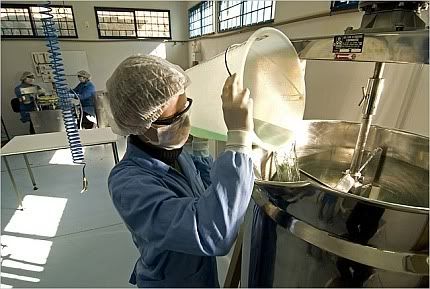Exportaciones de cosméticos de origen natural. Brasil.
WORLD BUSINESS/BEAUTY |
| A Nation Sells the World on Products Based on Amazon Ingredients By ANDREW DOWNIE Published: August 24, 2007 |
 Adriana Zehbrauskas for The New York Times Gilma Santos gets a shoulder treatment from Sandra Rojas, a spa manager in São Paulo, Brazil. |
SÃO PAULO, Brazil — Brazilians' longtime devotion to the body beautiful — whether it be spending fortunes on perfumes and cosmetics, slimming down to fit into minuscule swimsuits or revealing body waxing — is paying off. Exports of the country's beauty products have been rising quickly in the last few years. In 2006, Brazilian companies exported $484 million of cosmetics, toiletries and fragrances, said João Carlos Basilio da Silva, president of the Brazilian Toiletry, Perfumery and Cosmetic Association. That was up 152 percent from 2001, he said. In a retail market keen on the word "natural," the country's abundant supply of natural oils, fruits and plant extracts has played a crucial role, too, in the increase in sales. The Brazilian Amazon has around 13,000 plant species, according to the agricultural research agency Embrapa. Only a tiny fraction of those plants have been comprehensively analyzed and less than 1 percent currently provide active ingredients for cosmetics, according to experts. |
For years, Amazonia's indigenous peoples have celebrated fruits for their special qualities. The guaraná berry, for example, is known as a stimulant. The fruit of the cupuaçu tree is a source of oil celebrated for its moisturizing qualities. Açai, another berry, is high in antioxidants and rich in energy. And passion fruit is used throughout Brazil to calm nerves. All are now used in making cosmetics. Brazilian producers do not claim that those ingredients are better or healthier than those found in species growing elsewhere or that their ingredients are superior to traditional components like animal fats. But they do believe their "Brazilianness" is a major factor in the rising sales. Industry executives in Brazil say that the country's products are seen as somehow purer than ones from other parts of the world. "If you pick a rose from the Amazon and a rose from the middle of France, the Brazilian one will be a lot less polluted," said Eduardo Rauen, commercial director of Amazonia Natural, a company whose exports are expected to grow 35 to 50 percent this year. "Amazonia is more natural and that is our selling point." The executives also say sales have been helped by Brazilians' image as a healthy, attractive people who go all out to look good. "Here in Brazil we associate beauty with sensuality, spice," said Artur Grynbaum, the executive vice president of Boticario, the beauty world's biggest franchise operation and one with overseas sales growing by an average of 20 percent a year. |
 Paulo Fridman for The New York Times Paulo Fridman for The New York TimesA technician works on a line of beauty products based on caipirinha, a mix made from sugar cane liquor and lime. |
"If you pick a rose from the Amazon and a rose from the middle of France, the Brazilian one will be a lot less polluted," said Eduardo Rauen, commercial director of Amazonia Natural, a company whose exports are expected to grow 35 to 50 percent this year. "Amazonia is more natural and that is our selling point." The executives also say sales have been helped by Brazilians' image as a healthy, attractive people who go all out to look good. "Here in Brazil we associate beauty with sensuality, spice," said Artur Grynbaum, the executive vice president of Boticario, the beauty world's biggest franchise operation and one with overseas sales growing by an average of 20 percent a year. Another equally important factor is Brazil's rich history of miscegenation. The mix of European, indigenous, African and Japanese blood has created a nation with every conceivable skin tone, hair type and body shape. Manufacturers of beauty products are forced to cater to them all, meaning that no matter which overseas market is the target, they have a product to suit. Murumuru palm oil "is a powerful moisturizer and it is good for people with curlier hair, whether they live in Brazil, China or the United States," said Alessandro Carlucci, the chief executive of Natura, a direct sales company that is the biggest in Brazil, with 23 percent of the domestic market. "China has few people with curly hair, so murumuru won't sell well there," Mr. Carlucci said. "But in Brazil and the United States, there is an important portion of people who need their hair to be moisturized. Through the diversity of our active ingredients we can offer benefits to different countries and different ethnicities." The main destination for Brazilian beauty products is still South America, accounting for 61 percent of Brazil's exports. With a domestic market of 188 million people, economies of scale enable Brazil to produce beauty products for significantly less than its neighbors. That has prompted some companies to close their operations in places like Chile, Uruguay and Bolivia and move production to Brazil, Mr. Basilio da Silva said. Under President Luiz Inácio Lula da Silva, Brazil, however, has expanded its export horizons. Russia, Cuba and Angola have emerged as important customers. This effort has been aided by the Trade and Investment Promotion Agency, a government body that has been dedicated to creating and diversifying overseas markets for Brazilian goods since 2003. In conjunction with Abihpec, the agency has paid for dozens of small- and medium-size Brazilian companies to display at trade fairs across the globe, particularly in areas like the Middle East, Eastern Europe and Africa. That assistance has helped people like Veronika Rezzani promote her line of products based on caipirinha, the cocktail made from sugar cane liquor and lime. "The help from Apex was critical for me," Ms. Rezzani said. "They helped pay for me to go to my first international trade fair in Bologna, and if it hadn't been for them then I couldn't have gone. They help small businesses participate in international events at reduced costs." |
 Adriana Zehbrauskas for The New York Times Adriana Zehbrauskas for The New York TimesVanilda Tavares has Brazilian Fruit lip gloss applied at a spa in São Paulo. |
| There are still major obstacles to exporting for small producers. Just a year after setting up a line of caipirinha lip gloss, moisturizer, shower and bath gel, soap and exfoliating cream, Ms. Rezzani said she sells to or is negotiating deals with vendors in Denmark, Finland, France, Norway, Portugal, Sweden and Britain. She cannot take more orders because of a bureaucratic system known as the Radar. Under Brazilian law, small producers can export up to $20,000 each year through the mail and a limited amount more via normal export channels. But registering to increase that amount involves what Mr. Basilio da Silva said was a "stupid and nonsensical" bureaucratic process. Producers like Ms. Rezzani said they could export even more if the government would just cut the red tape. "We have all these people interested but we can't export because of the Radar," she said. "It makes me mad." Big companies are not affected by the Radar and expect to keep growing, buoyed by the Brazilian real, which is stronger against the dollar than at any time since 2000. Looks can be deceiving, but the future looks bright. |
| Related Skin Deep: No, I Haven't Been Mugged. Why Do You Ask? (August 23, 2007) |
Copyright by the New York Times 2007 |


0 Comments:
Post a Comment
Subscribe to Post Comments [Atom]
<< Home